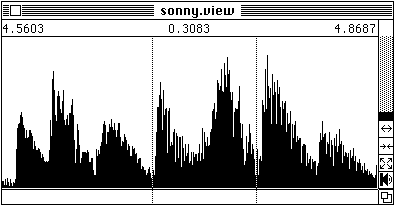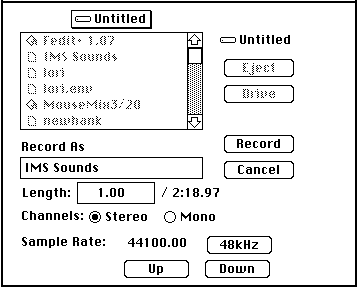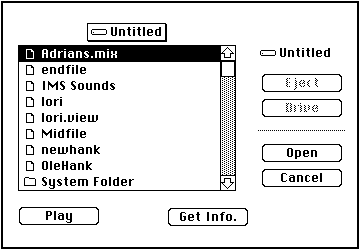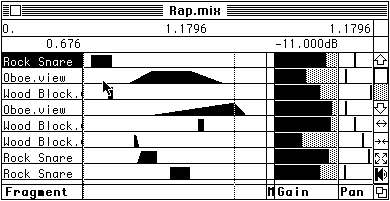
The MacMix program turns an appropriately equipped Macintosh computer into a digital audio workstation providing: disk-based digital recording, fast sound viewing, accurate and reversible editing, a simulated mixing console with unlimited channel capacity and a range of signal processing effects. All sound processing is done in software so that new effects may be added through software upgrades.
Digital audio has delivered one of its promises: high quality -- but at a price. Digital signal processing and storage is more expensive than analog signal processing and tape. For example, analog mixing consoles are the only choice for most applications. This situation will be reversed in the next decade. We will be able to work with the ease and economy of analog systems and all the advantages of digital audio fidelity.
Another promise of digital audio: greater and more precise control, remains elusive. To take advantage of these possibilities we will have to modify our working habits. This paper introduces a computer program which illustrates how audio engineering practice might change to take advantage of new technology: MacMix.
MacMix began as an experiment to see if the computer workstation concept could be applied to audio applications, and to explore new user interfaces and control strategies. The results were sufficiently encouraging to justify the commercial implementation, described here.
The single most important feature of MacMix is that it manipulates sounds recorded on hard disks. The advantage hard disks have over tape is very fast access -- sounds can be cued faster than we can specify the cues! A secondary advantage is that tracks need not be recorded synchronously.
Hard disks have many disadvantages in audio applications, despite advertisements from well known audio companies to the contrary. It costs more to store sound on them than on tape. When they go wrong (fortunately rarely), their entire contents can be destroyed. Disasters with tape often only involve short lengths of sound. A different discipline is required to safeguard sounds on hard disk.
Another disadvantage is the time it takes to load hard disks with sound. These disadvantages may disappear when high-speed removable optical media are available.
MacMix takes advantage of the fast random access of hard disks by providing a graphical display of sounds:

Without visual feedback it is hard to take advantage of the very fast access of hard disks. With MacMix you can define location points in the traditional way, by entering timecode, or you can use the mouse to identify cues on the graphical display. This last technique is often faster than listening to the sound. A simple example of this would be identifying pauses between songs in one hour of music.
Dialogue editors can also benefit greatly from a graphical display of sound. The graphical view should be displayed very rapidly at all scales or it will just get in the way of traditional location techniques. MacMix will display a fraction of a second of sound as fast as several hours - in under 1 second.
The record dialog box collects information required for the record process: the sample rate, the number of channels to be recorded and the sound length.
Re-recording is instantaneous: bad takes can be overwritten without ruining the creative flow waiting for a tape to rewind.

So far we have seen how MacMix provides the facilities of a hard-disk recorder. MacMix turns a recorder into a workstation by integrating functions which are traditionally performed by separate equipment: recording, archiving, editing, documentation (cue sheets), mixing and signal processing.

MacMix uses Apple's hierarchical file system to organize sounds into a tree-structured database.
The view window can be used for cutting pieces from sounds and replacement with silence, or fill. Selected fragments of sounds can be dubbed to new files with no generation loss. Edits can be undone as MacMix maintains a description of edits and never changes original recordings.
A mix window, as illustrated below, combines the functions of a cue sheet and a mixing console.

Slices of sound are stacked vertically like lines of text. A gain fader, mute and pan pot is available for each slice. Sounds are cued by dragging the polygonal icons along the horizontal time axis. Fade-in and fade-out times are changed by dragging the upper corners of the polygonal icons. Slices can be edited with the cut, paste and copy operations, much like lines of text are manipulated in a mouse-based text editor.
It is possible to work on a mix in small manageable pieces in one window, while maintaining a global view in another window. Mixing operations can be applied to anything from a few samples to many hours of sound. This means that MacMix can be used for anything from large final mixes to delicate sonic micro-surgery.
MacMix currently provides looping and envelopes. With the availability of higher performance machines such as the Macintosh II, it will be practical to implement equalization, reverberation and other computationally intensive signal processing algorithms.
The mix window described above does not have the feel of a mixing console. The major difference is that the faders do not immediately change a sound. You have to set them and then listen to the result. In many applications this is not too high a price to pay for the flexibility of the system, especially when console configurations can be saved and recalled automatically.
A powerful feature in view and mix windows provides some gestural control. When sounds are auditioned, MacMix logs clicks of the mouse button as tic marks underneath the cues or graphical view of the sound. These may then be used as accurate reference points for editing and mixing.
MacMix gives us a tantalizing hint of studio environments of the future. Studio equipment will be better integrated, easier to use, more efficient and of much higher sound quality. Much of the studio environment will be portable and cheap enough to bring digital audio to non-professionals. The extra creative leverage these new tools provide will be the exciting contribution of digital audio systems.